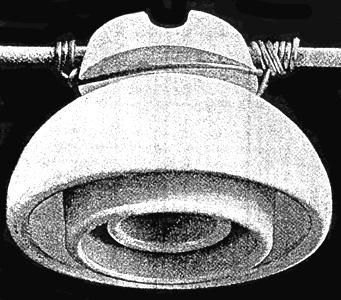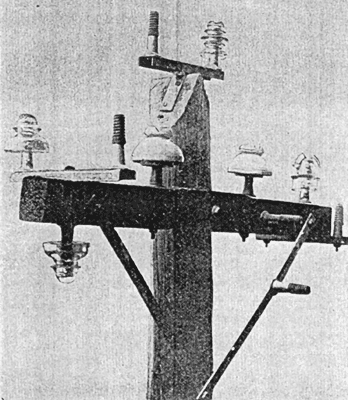[Trade Journal]
Publication: Western Electrician
Chicago, IL, United States
vol. 17, no. 23, p. 279, col. 1-2
Locke's Steel Insulating Pin and Insulator.
For overhead line construction Frederick [sic] Fred M. Locke of Victor, N. Y., has brought out the excellent appliances shown in the illustration. He has designed an indestructible insulating pin supplied with a steel bolt passing from the top of the pin through a half-inch hole in the cross-arm and securely fastened on the under side by a nut and washer. The iron cap between the top of the insulator pin and the cross-arm serves as a brace to resist the strain of the pull on the pin, thereby keeping out water and moisture and preserving the arm.
| |||
| Fig. 1. Locke's Insulator. |
The pin is practically unbreakable, and does not rot like a wooden pin. Another great advantage lies in the fact that it does not weaken the cross-arm nearly so much as the ordinary wooden pin, the difference in the diameters of the pin hole being that between one-half inch and 1-1/4 inch. The indestrucible steel pins have been extensively used as corner pins and on long-distance transmission lines where high potentials are used. They are convenient to replace broken wooden pins, or when extra wooden pins are needed between wooden pins already in use. As shown in Fig. 2, they can be used bottom side up on the underside of a cross-arm when it is desired to add wires to a line without increasing the number of cross-arms. For iron pole fittings a three-eighth inch by five inch pin is made, which can readily be attached, and when in place is neither cumbersome, expensive nor inconvenient, as is the case when ordinary blacksmith fixtures are used.
| |||
| Fig. 2. Locke's Steel Insulating Pin. |
In the picture are shown a few of the many uses to which the indestructible steel insulator pin may be put. As will be observed the pins can be attached to the top, bottom and sides of the cross-arm, or to pole tops, break arms or to cross-arm braces. Wherever placed they present a neat appearance, and may be depended upon to resist all reasonable strains of line construction. The illustration also shows the Locke patent break arm in position under and on top of the cross-arm, also the Locke triple petticoat porcelain insulator, triple petticoat glass insulator, transposition insulator, and cable insulator.
The triple petticoat china insulator, shown in Fig. 1, is made from the highest grade chinaware. It measures 5-1/4 inches in diameter and four inches in height, and has over 12 inches of surface between the wire contact and the supporting pin. About 10 inches of this surface is on the under side of the insulator, out of reach of direct rainfall, where it keeps comparatively dry. The surfaces of the bottom of the insulator are perpendicular, and, therefore, catch no foreign matter. By repeated practical tests it has been found that a potential of 85,000 volts is required to puncture the insulator; hence it will carry with safety and economy any voltage that is practicable for use in the commercial appliaction of electric power. The body and glaze of these insulators are of simple earths only, fused together into a vitreous, homogeneous mass at the greatest heat. No lead or other metallic oxide being used in making, the glaze is not a conductor. The body and glaze being of exactly the same material and fired at the same heat, the insulating qualities are as high without as with the glaze.


